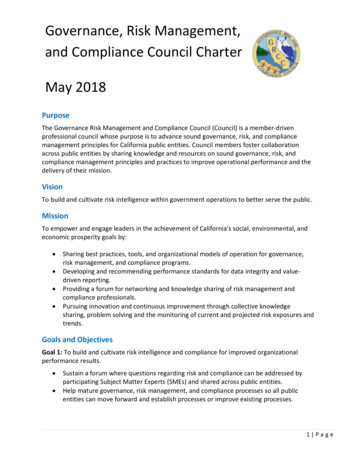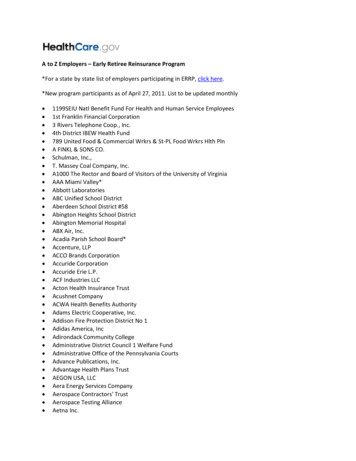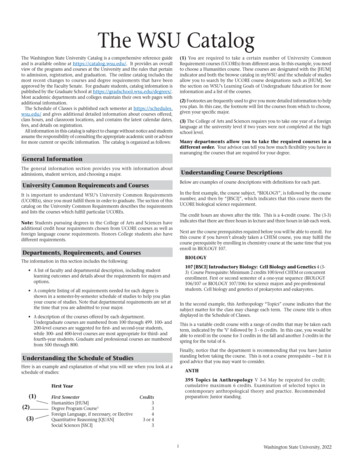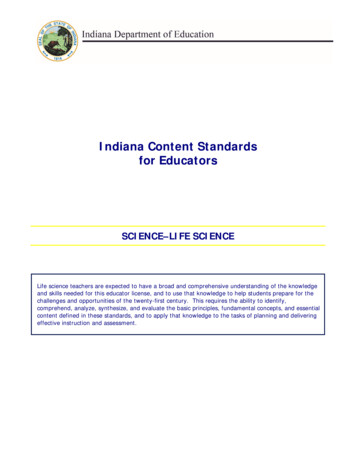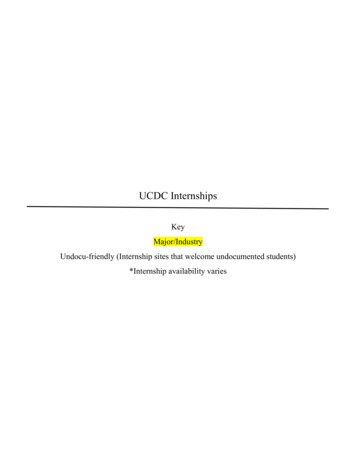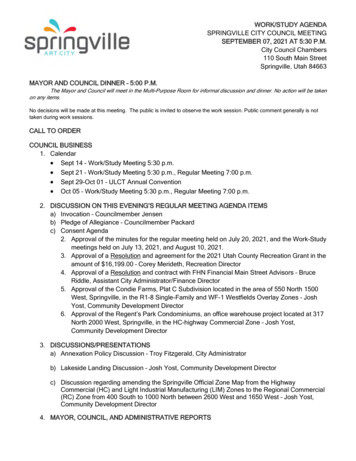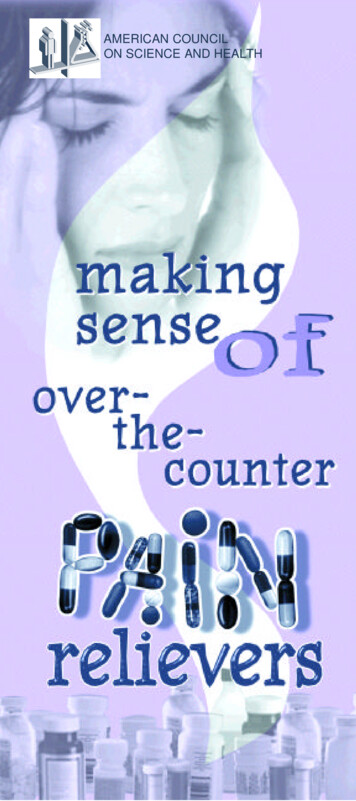
Transcription
AMERICAN COUNCILON SCIENCE AND HEALTH
Prepared forthe American Council on Science and HealthByAndrea Golaine Case, M.S.Project CoordinatorGilbert L. Ross, M.D.Medical Director,American Council on Science and HealthArt DirectorYelena PonirovskayaJanuary 2000AMERICAN COUNCILON SCIENCE AND HEALTH1995 Broadway, 2nd Floor, New York, NY10023-5860Tel. (212) 362-7044 Fax (212) 362-4919URL: http://www.acsh.org E-mail: acsh@acsh.org
THE AMERICAN COUNCIL ON SCIENCE ANDHEALTH GRATEFULLY ACKNOWLEDGES THE CONTRIBUTIONS OF THE REVIEWERS NAMED BELOW.Dale J. Chodos, M.D.Kalamazoo, MIMarvin J. Schissel, D.D.S.Woodhaven, NYSeymour Diamond, M.D.Diamond Headache ClinicEdgar J. Schoen, M.D.Kaiser PermanenteMedical CenterJohn E. Dodes, D.D.S.The National CouncilAgainst Health FraudSeymour Solomon, M.D.Montefiore Medical CenterWilliam Paul Glezen, M.D.Baylor College of MedicineFrederic M. Steinberg, M.D.Clothall, Baldock, U.K.Ruth Kava, Ph.D., R.D.American Council onScience and HealthWillard J. Visek, M.D., Ph.D.University of IllinoisAlicia Lukachko, M.P.H.American Council onScience and HealthRoger P. Maickel, Ph.D.Pharmacology andToxicology ConsultingR. T. Ravenholt, M.D.,M.P.H.Population HealthImperativesMiles M. Weinberger, M.D.University of IowaSteven M. Weisman, Ph.D.The Weinberg GroupElizabeth M. Whelan,Sc.D., M.P.H.American Council onScience and HealthEkhard E. Ziegler, M.D.University of IowaWilliam O. Robertson, M.D.University of WashingtonACSH accepts unrestricted grants on the condition that it is solely responsi ble for the conduct of its research and the dissemination of its work to thepublic. The organization does not perform proprietary research, nor does itaccept support from individual corporations for specific research projects.All contributions to ACSH—a publicly funded organization under Section501(c)(3) of the Internal Revenue Code—are tax deductible.January 2000-10000. Entire contents American Council on Science and Health, Inc.
Introduction . . . . . . . . . . . . . . . . . . . . . .5OTC Use of Common Pain Relievers . . . .5The Discoveries . . . . . . . . . . . . . . . . . . .6How They Work . . . . . . . . . . . . . . . . . . . . 7Comparing Effectiveness . . . . . . . . . . . . .8Pain Relief . . . . . . . . . . . . . . . . .9Convenience Combinations . . . . . . . . . . . 10Safety Concerns . . . . . . . . . . . . . . . . . . . 11Fever Reduction in Children . . . . 11Long-term Use . . . . . . . . . . . . . . 12Overdose . . . . . . . . . . . . . . . . . . 13Precautions, Contraindications,and Drug Interactions . . . . . . . . . 15New and Potential Future Indications . . . . 17CONCLUSION . . . . . . . . . . . . . . . . . . . . 25Table 1. OTC Pain Relievers (insert)Table 2. Some ConvenienceCombinations . . . . . . . . . . . . . . 20Table 3. Expanded AntiplateletIndications and DosingGuidelines of Aspirin . . . . . . . . . 21
The last 100 years have been more comfortablefor humankind as a result of the discovery and availability of over-the-counter pain relievers (or analgesics). This year marks the 100th anniversary of theintroduction of aspirin by Bayer. It was not until 1955that acetaminophen (Tylenol) became available overthe-counter (OTC) in the United States. Ibuprofen(Advil, Motrin, Nuprin) joined the over-the-counterarsenal 19 years later. And 1994 and 1995 broughtU.S. Food and Drug Administration (FDA) approvalof OTC naproxen sodium (Aleve) and ketoprofen(Actron, Orudis KT), respectively. Today, there aremany choices of pain relievers and fever medications,but selecting one does not have to be a headache!Each of these medications has been proved safeand effective, and in most cases, any one of themwould be a reliable choice for pain relief and/or feverreduction. However, there are unique properties anddifferences that make specific products more desirable for certain conditions or individuals. This reportwill provide information that will help readers differ entiate among and select appropriate OTC painrelievers. It will review the effectiveness and safety ofthe five pain medications currently approved for OTCuse. In addition, it will alert readers to side effects,drug interactions, and conditions under which certainmedications should not be used. Finally, relativelynew and potential future uses will be discussed.The FDA recognizes two broad classes of drugs:OTC, or nonprescription, drugs, and Rx, or prescription, drugs. OTC agents are those that can be safelyself-administered for short periods of time without aphysician’s prescription or guidance. Prescriptiondrugs, on the other hand, require a prescription to bedispensed and are taken under the guidance of ahealth care professional.The five pain relievers discussed in this manuscript are illustrated in Table 1 (see insert).7
MAKING SENSEOF OVER –THE–COUNTER PAIN RELIEVERSAspirin is the safe, modern form of a class of painrelieving compounds called “salicylates,” which havebeen used for millennia. Some 2400 years ago,Hippocrates provided the first written record recommending the consumption of willow bark extract (whichwas later discovered to contain salicylates) as treatmentfor the pain of childbirth. Since then, from ancientGreece to Europe in the Middle Ages, there have beenmany references that advise using willow leaves andbark for the treatment of a variety of conditions.In the mid- to late 1800s, salicylate compoundswere prepared in the laboratory, refined, and tested. Inthe 1890s, a chemist at Frederich Bayer and Company(present-day Bayer Corporation) tested a number ofsalicylate compounds and concluded that acetylsalicylic acid (aspirin) brought together the best combination of pain relief and safety. Bayer introducedaspirin in 1899. Shortly thereafter, other companiesfollowed with the manufacture of their own brands ofaspirin. Today aspirin ranks second only to alcohol asthe most consumed drug in the world. In the UnitedStates alone it has been reported that annual aspirinconsumption is in the neighborhood of 77,000 tons.Acetaminophen belongs to a class of compoundsthat first had medical applications in the 1880s. Othermembers of the class were more popular at first butwere later withdrawn from the U.S. market becausethey caused serious kidney problems. Acetaminophenhas proved to be a safe form of this class of drugs andhas been available as an OTC pain reliever in theUnited States since 1955.The next major event in the development of OTCanalgesics occurred in 1953, when researchers startedsearching for safer and more effective drugs for thetreatment of rheumatoid arthritis. Eventually, a compound named ibuprofen was found to have a goodsafety profile in animal studies, as well as pain-relieving and fever-reducing properties, and also acted asan anti-inflammatory agent.The first clinical trials demonstrating the efficacyand safety of ibuprofen in rheumatoid arthritispatients occurred in the 1960s. The drug, brandnamed Motrin, was approved for prescription use inthe United Staes in 1974, and was approved for OTC8
MAKING SENSE OF OVER–THE–COUNTER PAIN RELIEVERSuse in 1984.Because of their demonstrated safety and efficacyin clinical trials, naproxen (brand-named Naprosyn)and ketoprofen (Orudis) were granted prescriptionapproval by the FDA in 1976 and 1986, respectively.Naproxen sodium (Aleve) was granted OTC approvalin 1994, followed by the OTC approval of ketoprofen(Actron, Orudis KT) in 1995. Over time, confidencein their safety grew along with evidence of theireffectiveness at higher prescription doses.Aspirin, ibuprofen, naproxen sodium, and ketoprofen are all characterized as nonsteroidal antiinflammatory drugs (NSAIDs) and act similarly.They work primarily at the site of injury or pain tolessen discomfort and prevent inflammation (theswelling, pain, and redness that result from an injury).They help to reduce fever by affecting an area in thebrain. These properties of NSAIDs are believed toresult from their ability block the production of certain compounds, called prostaglandins, that are produced by the body.Prostaglandins are hormone-like substances thathave a wide range of effects. Prostaglandins play arole in many bodily functions, including pain modulation, temperature control, and blood clotting. It isthe blockage of prostaglandin production that underlies all of the beneficial—and adverse—effects ofNSAIDs. Prostaglandins are important in the transmission of pain by sensitizing nerve endings, makingit easier for them to send pain messages to the brain.Prostaglandins also are important in causing fever. Byblocking the production of prostaglandins, aspirinand the other NSAIDs reduce the severity of painrelated to inflammatory processes, and reduce fever.Aspirin, more than the other NSAIDs, alsoreduces blood clotting by inhibiting platelets fromsticking together, or aggregating. Aspirin irreversiblyblocks the enzyme cyclooxygenase (COX), whichallows platelets to clump or aggregate. This is whythat low doses of aspirin are now recommended forsome patients at risk for heart attack and for those atrisk of stroke caused by blood clots in the brain.9
MAKING SENSEOF OVER –THE– COUNTER PAINRELIEVERSLike NSAIDs, acetaminophen has pain-relievingand fever-reducing activity. Unlike NSAIDs, acetaminophen is believed to inhibit prostaglandin synthesis primarily in the central nervous system (the brain).It does not have anti-inflammatory benefits, nor doesit reduce blood clotting. Therefore, it does not haveany protective effect against heart attack in at-riskpatients.All the medications discussed in this report areobviously safe and effective enough to meet theFDA’s criteria to be made available OTC to the public. They have been proved in clinical trials to workeffectively and quickly without causing undue risk topatients.Clinical trials involve the testing of medicationsunder controlled conditions. The OTC medicationsdiscussed in this report have been tested under suchconditions to determine whether they are effective inrelieving pain that may result from sore throat or dental surgery, headache pain, menstrual pain, musclesoreness, and arthritis. They have also been tested fortheir ability to reduce fever in children and adults.Each of the OTC medications discussed here has beenproved safe and effective for all these indications,except for certain conditions involving aspirin use inchildren (see “Fever Reduction in Children,” page 11).As consumers, we seek the most effective medications for our pain and fever. What works well for oneperson may not work well for another. We seek thefastest-acting, longest-lasting treatments with few, ifany, side effects. Perhaps the data from these clinicaltrials can help us select the appropriate drug.However, comparing the effectiveness of the variousOTC agents is difficult. First, many of the publishedstudies supporting the effectiveness of these medications were performed at doses above the approvedOTC range. In reality, to claim that one OTC analgesic works better than another, each must have beenstudied at the OTC dose. Also, with regard to the newgeneration of NSAIDs, much of the data comparingthese agents to one another and to older OTC drugsare not available to the general research community.10
MAKING SENSE OF OVER–THE–COUNTER PAIN RELIEVERSThe following presentation is an attempt to explainand compare the available research on OTC pain medications. A summary of the data in the following section of the report can be found in Table 2 (page 20).For relief of pain, aspirin and acetaminophen are,in general, equally effective. With a 650-mg dose(two tablets) of either aspirin or acetaminophen, painrelief begins within one hour and lasts about fourhours. Aspirin has demonstrated effectivenessagainst muscle soreness resulting from exercise oroverexertion. Acetaminophen has not been shown tobe as effective for this condition. Both have provedequally effective for headache and menstrual pain.For both medications, higher doses, up to the maximum approved OTC dose of 1000 mg, result instronger pain relief.Caffeine at doses equivalent to a strong cup ofcoffee has been shown to enhance the effectiveness ofaspirin, acetaminophen, or their combination.Caffeine/pain reliever combinations have been marketed as Excedrin Extra Strength and ExcedrinMigraine and are effective in reducing the pain, nausea, sensitivity to light and sound, and the functionaldisability associated with migraine headaches.Classifying aspirin and acetaminophen as “mildanalgesics,” which is how they are often described inthe medical literature, underestimates their effectiveness against pain. Actually, 500 mg or more of aspirinor acetaminophen consistently equals or surpasses thepain-relieving characteristics of marketed doses oforal narcotic agents, including 60 mg of codeine (theamount in two Tylenol #3 tablets) or 5 mg of oxycodone (the amount in one Percocet tablet).When comparing OTC doses of the newerNSAIDs with aspirin or acetaminophen, a trendemerges: a single dose of naproxen sodium (220 mg),ibuprofen (200 mg), or ketoprofen (12.5 mg) isroughly equivalent in strength to higher doses ofaspirin or acetaminophen. Maximum OTC doses ofthese agents (440 mg of naproxen sodium, 400 mg ofibuprofen, or 25 mg of ketoprofen) appear moreeffective than either aspirin or acetaminophen. Theywork for a longer duration and effectively combat a11
MAKING SENSEOF OVER –THE–COUNTER PAIN RELIEVERShigher degree of pain.Aspirin and acetaminophen, 650 to 1000 mg, generally begin to relieve pain within 60 minutes andrelieve pain for 3 to 6 hours. Studies have shown thatnaproxen sodium, 220 to 440 mg, begins to relievepain within 60 minutes and relieves pain for 8 to 12hours—the longest duration of action among the OTCproducts. Ibuprofen, 200 to 400 mg, relieves painwithin 60 minutes and lasts for 4 to 8 hours.Ketoprofen, 12.5 to 25 mg, has analgesic propertiessimilar to those of ibuprofen, 200 to 400 mg (SeeTable 1, insert).Naproxen sodium and ibuprofen have been especially effective for dental, throat, and headache pain,as well as muscle soreness. Few studies have beenpublished evaluating OTC doses of the newerNSAIDs for menstrual pain (dysmenorrhea), but theydo show some efficacy and are widely used for thiscondition.Convenience combinations typically containaspirin, acetaminophen, or ibuprofen plus at least oneother entity, such as a nasal decongestant, antihistamine, cough suppressant, or antacid. These other entities simultaneously treat other symptoms that mayaccompany pain and fever. Examples of just a few ofthe marketed combinations are found in Table 2(page 20). These combinations can be worthwhile ifin fact the patient has a variety of symptoms.However, they are often misused by the public, whichleads to needless exposure to one or more of the constituents. For example, a patient complaining of nasalcongestion without fever or headache is best treatedwith a nasal decongestant, not a combination that alsocontains aspirin, acetaminophen, or ibuprofen.Likewise, a patient experiencing only pain or fevershould ingest a single-entity pain reliever such asnaproxen sodium or ibuprofen. The additional constituents do not enhance pain relief; they only increase the risk of side effects.12
MAKING SENSE OF OVER–THE–COUNTER PAIN RELIEVERSAs with all drugs, unwanted effects are possiblewith OTC analgesics. All the OTC pain relievers,except acetaminophen, should be avoided during thethird trimester (last three months) of pregnancy. Ifmore than three alcohol-containing drinks per day areoften consumed, that fact should be discussed with aphysician before deciding on an OTC analgesic.Concomitant use of aspirin, naproxen sodium,ibuprofen, or ketoprofen and alcohol can increase therisks of gastrointestinal bleeding and ulcers.Concommitant acetaminophen and alcohol use canincrease the risk of liver damage. Acetaminophen isknown to damage the liver directly, although (exceptin chronic alcohol abusers) this occurs only in overdose. If there is a history or suspicion of excessivealcohol intake, acetaminophen should be avoidedunless specifically recommended by a physician.Fortunately, severe side effects from OTC analgesic use are rare, and their occurrence usuallydepends on the dose and duration of administration.Occasional OTC analgesic use that adheres to maximum dosage guidelines is generally considered safe.At prescription doses over longer periods of time,there are higher risks, which may increase with age,the use of other medications, or the presence of acomplicating condition. As with any medication,intentional and unintentional overdose can cause serious consequences, including death.In the pediatric population, the primary use ofOTC medications is for the reduction of fever.However, there is considerable controversy concerning their routine use. Arguments against their use citethe ability of fever to enhance the immune response,the fact that even without medications fevers usuallyend quickly, and the ability of fever reducers to masksigns important for diagnosis, prognosis, or assessment of the response to antibiotics. Arguments supporting the routine use of fever-reducing medicationinclude the prevention of seizures due to fever inyoung children and the enhancement of patient comfort. Even these seemingly rational arguments for theuse of anti-fever agents are not convincingly support13
MAKING SENSEOF OVER–THE–COUNTER PAIN RELIEVERSed by scientific studies.OTC analgesics are widely employed by the general public to relieve and comfort young children withfever, and more often than not, they are recommended by physicians to parents and patients for the control of fever. As of this date, OTC naproxen sodiumand ketoprofen are not indicated for use in childrenunder the ages of 12 and 16 years, respectively.Acetaminophen has proved to be an effectivefever reducer in children. In one study, it caused feverto decline within 30 minutes. Peak effectiveness wasreached in about three hours, and effectiveness ebbedby the sixth hour. Sponging the child with tepid waterhas been shown to be as effective as using anti-fevermedication, and the two used in combination weremore effective than either treatment alone. The feverreducing effects of ibuprofen have also been wellstudied in children. Ibuprofen begins to reduce feverwithin 30 minutes, with a duration of action of six toeight hours.Aspirin should not be used to reduce fever inchildren, because of the threat of a conditioncalled “Reye’s syndrome.” First described in 1963,Reye’s syndrome is an acute childhood illness thatproduces brain inflammation and liver disease.Infants and children may develop Reye’s syndromeafter a viral infection such as influenza or chickenpox. Symptoms—including tiredness, agitation, delirium, and seizures—appear suddenly. Without aggressive treatment, the disease progresses to deep coma,brain dysfunction, and, in 80% to 90% of cases,death. In the 1970s and 1980s, studies suggested astrong association between aspirin therapy andReye’s syndrome. Expert panels of pediatricians recommend that children not be treated with aspirinfor flu-like symptoms, fever, or chickenpox.Parents have taken this advice, and the incidence ofReye’s syndrome has decreased.Acetaminophen,naproxen, and ibuprofen have not been implicated inthe induction of Reye’s syndrome.In many ways, we are dealing with two differentdrugs when we compare a medication taken withinthe guidelines of the OTC labeling with the same12
MAKING SENSE OFOVER –THE–COUNTER PAIN RELIEVERSmedication taken at higher doses and over longerdurations. These higher-dose and longer-durationuses are best referred to as prescription conditions.Under these conditions, there is a greater expectation of efficacy, but there is also a greater likelihoodof adverse drug reactions than with standard OTCusage, when medications are taken at lower dosesfor shorter periods of time. However, when suchdosage is used under a health professional’s guidance, the benefit is usually thought to outweigh thepotential risk. For example, a patient with asprained ankle who consumes a maximum OTCdose of 660 mg of naproxen sodium for 10 days isless likely to suffer adverse effects than an arthritispatient who consumes a prescription anti-inflammatory dose of 1000 to 1500 mg of naproxen per dayfor many months.The most serious side effects associated withlong-term, high-dose (prescription) use of NSAIDsare gastrointestinal (GI) problems and kidney abnormalities. These problems are believed to result fromthe NSAIDs’ ability to inhibit prostaglandin production. In the GI tract, especially the stomach and duodenum, prostaglandins decrease acid secretion andincrease the production of protective mucus andbicarbonate, which protect the stomach from injury.In the kidneys, prostaglandins help maintain bloodflow, especially in people with preexisting kidney disease.Taking excessive doses of acetaminophen, or taking it in conjunction with alcohol, has caused seriousliver problems. This is discussed at some length in“Precautions, Contraindications, and Drug Interactions” (page 15).The potential for accidental or intentional overdose with any medication is an important publichealth concern. According to the AmericanAssociation of Poison Control Centers, there were128 deaths attributed to aspirin overdose and 124deaths attributed to acetaminophen overdose between1988 and 1993. During this reporting period, only onedeath was attributed to ibuprofen overdose, and nodeaths were attributed to naproxen/naproxen sodium15
MAKING SENSEOF OVER –THE–COUNTER PAIN RELIEVERSoverdose. These low numbers may reflect not onlythe relative safety of these products, but also the factthat they were used less commonly.Aspirin overdose remains a relatively commonmeans of attempting suicide in young adults. It was(before Reye’s Syndrome warnings) also a major culprit in accidental overdoses in children younger thanfive years of age. Serious effects of aspirin overdosetypically occur at doses in excess of 15 to 25 tabletsin adults. In children, toxicity was often the result ofa therapeutic overdose; that is, the parent administered two to four times the recommended dose for aperiod of several days. Fatalities in children andadults can result without proper medical care. Theearly signs of overdose usually appear within the firstthree to four hours after ingestion and include nausea,vomiting, ringing in the ears, fever, and hyperventilation. Visual disturbances, hallucinations, delirium,and seizures can also occur. The treatment of aspirinoverdose is primarily supportive. It may involvepumping of the stomach and administration of substances to prevent absorption, promote excretion, andcombat chemical imbalances and dehydration.Acetaminophen, like the NSAIDs, is a safe agentwhen used as recommended. However, its true lethalpotential is often underestimated, especially by adolescents. Overdosage can lead to serious, even fatal,liver damage. Not uncommonly, an attention-getting“suicidal” gesture using acetaminophen becomes atragic reality. It is estimated that acute doses of morethan 6 g (20 tablets) are necessary for liver toxicity tooccur. In children under ten years of age, multiplemiscalculated overdoses administered by their parents (as in the pediatric aspirin overdose scenario)have also led to severe liver damage.To prevent permanent liver injury or death, theimportance of administering the antidote, N-acetylcysteine, within 16 hours of acetaminophen ingestioncannot be overemphasized. The major problem indealing with an acetaminophen overdose is the delayin observable symptoms. During the first 12 to 24hours after an acetaminophen overdose, few if anysymptoms occur, even with large ingestions. Thepatient is not perceived as ill, and unfortunately thefirst 24 hours represents the period when the antidote14
MAKINGSENSE OF OVER–THE–COUNTER PAIN RELIEVERSwill be of most benefit. It is not until after 24 hoursthat symptoms of nausea and vomiting and abnormalliver function become evident. So while a highlyeffective antidote exists, the overdose is often diagnosed too late.Like other drugs that have gained OTC approvalafter prescription use, a marked increase in reports ofoverdose reactions occurred following ibuprofen’s1984 OTC approval. However, there has not been anyevidence to contradict ibuprofen’s prescription claimsof relatively low toxicity. In adult cases of intentional overdose, there appear to be few serious risks ifless than 6 g (30 tablets) is ingested. In addition, allpatients who become symptomatic do so within fourhours of an acute ibuprofen overdose. This is unlikethe slow, insidious nature of acetaminophen overdose.Acute overdose reactions to naproxen and naproxen sodium have rarely been reported. Even patientsingesting very high doses (up to 35 g) completelyrecovered with appropriate medical care. As withother OTC analgesics, naproxen sodium appears to besafe when used as directed.Although OTC pain relievers are generally considered safe, even low-dose and short-duration exposuremay place certain patients at risk. Patient informationprovided for OTC pain relievers specifically list threewarnings, concerning aspirin allergy, pregnancy, andconcomitant alcohol use. In addition, aspirin productscarry a warning about bleeding disorders and Reye’ssyndrome. There are also risks in combining the use ofpain relievers and certain other pharmaceuticals.Aspirin and the other NSAIDs have been associated with an allergic reaction whose symptoms rangefrom stuffy nose and rash to severe asthma. In theoverall population, this syndrome has a low incidence, of less than 1%. However, it has been estimated that 10% to 28% of adult asthma patients may beintolerant to aspirin. Patients with a history of aspirinsensitive asthma or allergy must avoid naproxen sodium, ibuprofen, and ketoprofen, because these drugs15
MAKING SENSE OF OVER–THE–COUNTER PAIN RELIEVERSalso may precipitate a serious allergic reaction.While acetaminophen is usually considered a safealternative in these patients, it was recently reportedthat as many as one third of those aspirin-sensitiveasthmatics are also sensitive to high doses of acetaminophen.The use of aspirin or any of the other NSAIDsshould be avoided by pregnant women. NSAIDs caninhibit labor and prolong pregnancy and may alsoincrease bleeding risk associated with delivery.Additionally, maternal NSAID use can result in circulatory problems in the newborn. Aspirin should beavoided during pregnancy, particularly late in pregnancy, because it is associated with delivery complications and excessive bleeding after delivery. Earlierin pregnancy, chronic use of aspirin has been associated with anemia in expectant mothers. Acetaminophenis generally considered the best choice for managingminor pains and fever in pregnancy.Long-term, high-dose use of the newer NSAIDshas been implicated in counteracting the blood pressure–lowering effects of many antihypertensiveagents. This interaction has not, in general, been associated with short-term low-dose OTC therapy.Mixing alcohol with pain relievers presents anumber of potential hazards. The combined use ofalcohol and NSAIDs can significantly increase therisk of ulcers and blood loss. The use of NSAIDsshould be separated from alcohol consumption by atleast 12 hours. The FDAhas mandated that manufacturers of all OTC aspirin-containing and NSAID-containing products include in their labeling the warningthat patients who consume three or more alcoholicdrinks per day should contact their physician beforeingesting aspirin, naproxen sodium, ibuprofen, orketoprofen because the combination may increase therisk of stomach bleeding.Prolonged use of alcohol and acetaminophen cancause severe liver damage. The FDA has mandatedthat manufacturers of acetaminophen-containingproducts include in their labeling the warning thatpatients who consume three or more alcoholic drinksper day should contact their physician before ingesting acetaminophen because the combination mayincrease the risk of liver damage.16
MAKINGSENSE OF OVER–THE–COUNTER PAIN RELIEVERSSerious bleeding, or hemorrhage, can be a complication of anticoagulant (“blood-thinning”) therapy.Thirty percent of patients requiring long-term treatment with these medications, which inhibit blood clotting, suffer this side effect. The combination of anticoagulants and NSAIDs can be dangerous. Carefulphysician monitoring of this combination is required.Aspirin has been approved as a daily therapy toprevent life-threatening cardiovascular problems,such as heart attack (M.I.) and stroke. Aspirin and theother NSAIDs are also being investigated for theirpotential to prevent colorectal cancer and to preventor lessen the symptoms of Alzheimer’s disease.NSAIDS may also be effective in dental and periodontal (gum) disease, which can result in tooth loss.As previously discussed, aspirin irreversiblyblocks the COX enzyme system that causes plateletsto clump. This is the rationale for long-term aspirintherapy in the prevention of heart attack and stroke(caused by blood clots in the brain) in certain highrisk patients. On October 23, 1998, the FDA published a new set of expanded indications with definitive dosing guidelines for each condition. They aredescribed in detail in Table 3 (page 21). Low doses ofaspirin (325 mg—one pill—or less per day) are recommended for people who have already suffered aheart attack, those with angina, and those who haveundergone procedures such as coronary bypass.Aspirin is also recommended for patients in the acutestages of a heart attack. Taking aspirin for these andother conditions has proved effective in reducing therisk of future cardiovascular events. However, use ofaspirin for these indications requires the supervisionof a physician or other licensed practitioner.There is considerable interest in the possibilitythat aspirin and the other NSAIDs may retard or pr
drug interactions, and conditions under which certain medications should not be used. Finally, relatively new and potential future uses will be discussed. The FDA recognizes two broad classes of drugs: OTC, or nonprescription, drugs, and Rx, or prescrip - tion, drugs. OTC agents are those that can be safely



